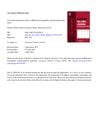Search
forLearn
3 / 3 resultslearn Osteopontin
signaling protein that, when suppressed, may grow hair by reducing inflammation and stem cell loss
learn Epidermal Growth Factor
Research
5 / 1000+ results
research Core-Shell Nanocarriers Based on PEGylated Hydrophobic Hyperbranched Polyesters
The new nanocarriers improve how well water-insoluble drugs dissolve and allow for controlled drug release.

research Bioabsorbable Nano-Micelle Hybridized Hydrogel Scaffold Prevents Postoperative Melanoma Recurrence
A special gel with medicine helps prevent melanoma from coming back after surgery.
research Core-Shell and Core-Amphiphilic Branched Shell Nanocarriers Based on Biodegradable Hyperbranched Polymers as Potential Drug Delivery Systems
The new biodegradable nanocarriers safely and effectively deliver drugs into the skin.

research Modern Drug Delivery Strategies Applied to Natural Active Compounds
New drug delivery methods can make natural compounds more effective and stable.

research Traditional Chinese Medicine Derived Exosome-Like Nanovesicles in Wound Repair and Skin Regeneration
TCM-derived nanovesicles show promise for wound healing and skin regeneration but need more research.
Community Join
5 / 51 resultscommunity Androgenetic alopecia is a skin disease: DHT-mediated skin disorders
Dihydrotestosterone (DHT) impacts various skin conditions, including Androgenetic alopecia and seborrheic dermatitis, by causing overactivity in sebaceous glands. Topical medications Tacrolimus and Clobetasol can reduce these inflammatory conditions, and treatments like RU58841, Minoxidil, and Finasteride may also be beneficial.
community DHT Itch is real. The connection between Acne and Male Pattern Baldness shows this
The conversation discusses the link between seborrheic dermatitis, acne, and male pattern baldness, suggesting that DHT may cause both skin conditions and hair loss. Treatments mentioned include RU58841, finasteride, dutasteride, minoxidil, Nizoral shampoo, and other topical anti-androgens.

community FCE 28260: A Forgotten 5α-Reductase Inhibitor
FCE 28260 (PNU 156765), an under-explored 5α-reductase inhibitor, showcases promising results in research by Giudici et al., outperforming well-known treatments like Finasteride in reducing the conversion of testosterone to DHT. Its superior efficacy, demonstrated through lower IC50 values in both natural and human recombinant enzyme studies, suggests it could offer more effective management of DHT-related conditions. Additionally, its lower molecular weight hints at better potential for topical application, potentially offering advantages in treating conditions such as androgenic alopecia. Despite its potential, it has not advanced in development, possibly due to financial limitations, leaving its therapeutic prospects and side effect profile largely unexplored.
community What Determines Sulfotransferase Enzyme Levels In The Body?
Some people have low sulfotransferase enzyme levels, affecting their response to minoxidil. Lifestyle factors, genetics, and diet, like MSM intake, might influence these enzyme levels.
community Is 2-deoxy-D-ribose (2dDR) good for human hair?
Topical 2-deoxy-D-ribose (2dDR) regrows hair in mice almost as well as 2% Minoxidil. However, 2dDR may contribute to oxidative stress and hair loss due to the formation of advanced glycation end products (AGEs).